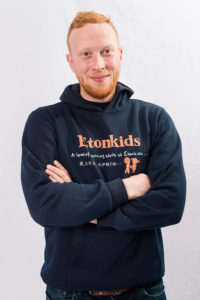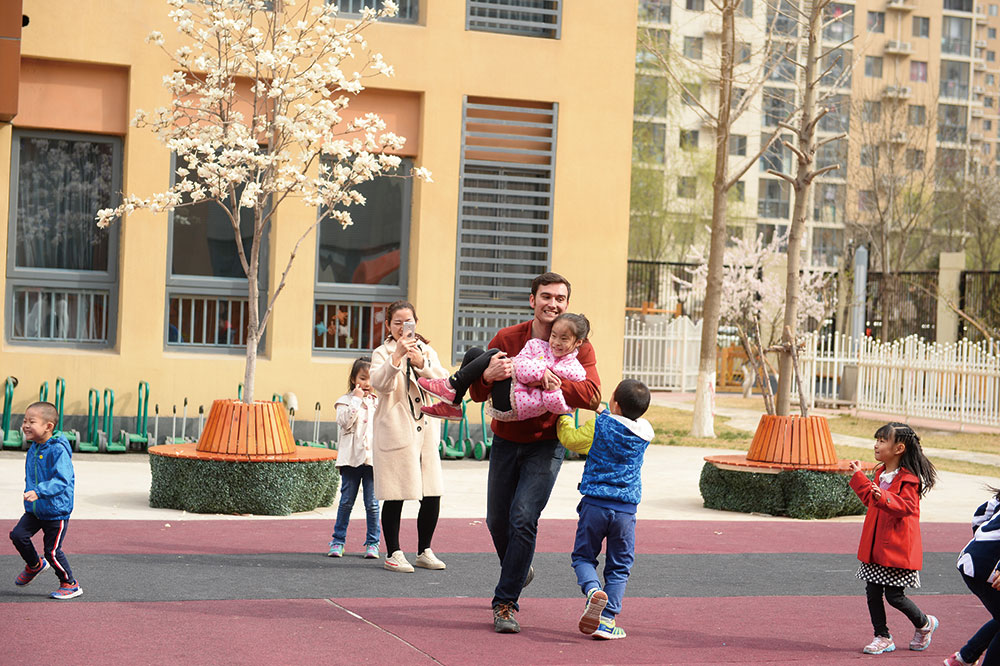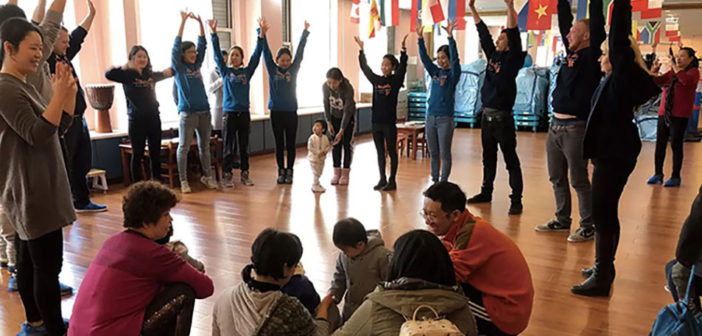When we think of a classroom, we probably imagine rows of kids sitting quietly, and a teacher at the front talking. If we walked into a room where the students were walking around, making nonsense noises, shouting, or even dancing, we might imagine that the class is out of control.
In two Beijing kindergartens though, we might instead be witnessing inspirational teachers using innovative techniques to teach English as an Additional Language (EAL).

Daniel Rothwell
Daniel Rothwell (pictured right) freely admits he was a disruptive influence in class even as a student.
“I was at an all-boys grammar school, and I was always in trouble,” he told us. “Then one time, instead of punishing me, a teacher suggested I try out for the Public Speaking team. When I protested, he said, ‘well, you like the sound of your own voice, and you like to argue!”
Rothwell went on to win a prize at his first attempt, and so began a lifelong love of performing, as a musician, public speaker, and actor. He is now Head of Drama at Etonkids, where he’s rolling out a new drama program and training teachers to incorporate dramatic teaching techniques in EAL.
“Calling it drama is a little bit heavy,” he explained. “It’s more a kind of applied practical linguistics. The focus of the teaching is not what you’re saying, but how you’re saying it. Part of my job is to teach the speech patterns of English. Mandarin is a tonal language, and so is English: tone of voice, and pitch are important. Playing with that is a great way to teach a sentence or a phrase. How would a sad person say this? How would a donkey say it? Or a ghost?
“So we start with sounds first, no words. They have an emotion to express, but can only say ‘blah blah blah’. So, for example, they might express agitation with a rising tone. It’s amazing how quickly the kids get into it.”
The students walk around for this exercise, holding conversations with each other in nonsense words, and getting them up out of their chairs is a key part of Rothwell’s approach.
“They’re constantly on the move,” he said. “We have 15 to 25 kindergarten kids, all active, roleplaying conversations, acting as animals…”
But it’s not as chaotic as it might seem.
“Every month has a theme, and a book,” Rothwell said. “Currently we’re reading The Gruffalo, and the theme is ‘Imagination’. If you had the wings of a bird and alligator legs, how would you move?”
Rothwell brings his musical skills to the classroom too.
“Rhythm is the buzzword here,” he told us. “For The Gruffalo, I use a djembe [an African drum]. The snake is a rapid patter on the edge of the drum, the fox prances through, the owl has a slower beat like wings, and the mouse a fast beat. And the Gruffalo himself – ”
He mimes the monster’s pounding footsteps.
“The kids learn to associate the drumbeat with the character. By the third lesson, they can hear the beat and transform into the animal.”
Rothwell uses his own experience of being the class troublemaker to keep the class in line.
“I always say they’re not naughty, they’re just over-inspired learners!” he laughs. “I can recognize what a kid is going to do before they do it. Often they’re bored and want to get on because they understand it, so I get them up to the front to demonstrate. With natural leaders, I try to train them to be more team players, and I try to draw introverts out of their shell, but never forcing anyone to do anything they don’t want to do.”
It’s an approach that can be challenging for more traditional teachers.
“If you don’t feel silly in front of a class, then you’re not doing it right,” Rothwell says. “That is the crux of all the training sessions. A lot of teachers are scared, or they don’t know that it’s acceptable to have fun.
“Initially, in training, a lot of them think I’m a nutcase, so I teach them to beatbox. It’s a warm-up, but also they realize I taught them something pretty cool, and they don’t feel so stupid. In the end, teachers like it because it helps with the kids’ English, and it’s fun for them too.”
Parents have also come round to Rothwell’s style.

“I’m covered in tattoos, so I don’t look like what they think of as a teacher. But they see the kids come in and leave with a smile on their face, and also their English getting better and better: their tone of voice, creativity, self-confidence, and communication skills. Once you’ve got the parents on board, the school are happy. It’s positive responses all around.”
The most important thing for Rothwell is that both students and teachers enjoy themselves.
“What I’ve come to realize over the last two years is that the schooling they’re going to go through is going to be tough, so I can let them have some fun now. A kindergarten class is pure imagination and personality. A lot of them have a hard time at home, so when they feel respected then they feel like they’ve achieved something.”
Rothwell is not the only teacher to bring performing techniques to the classroom. Bobby Wayne Jencks, Director of the English Department at Beijing SMIC Nanhaizi Kindergarten, uses his dancing skills to explain prepositions.

Bobby Wayne Jencks
“I stood at the front of the classroom,” he told us, “and said around, this is around me, and none of the students really knew what it meant. I drew the picture on the board and they kind of understood the concept. But it wasn’t until I asked one of the students to come up and I started dancing with her. I said I’m going to turn her around, so I turned her around and twirled her.
“After that, all the students were saying, ‘I really want to come up and dance with the teacher!’ I said, ‘If you want to come and dance with me, you have to tell me what this word is.’ And the whole class was just shouting ‘around, around.’
“And then for the preposition over, there’s this really fun swing dancing move, where I reach over the student and I practically make the student do a backflip. Of course, it’s very safe, because I have my hand over the student’s waist, so there’s no way for them to fall. And they’re very light, I’ve done this many times with people who weigh nearly as much as I do. So I taught the students this is over, and the students are just ecstatic about this, and screaming ‘over, teacher, over! I want you to flip me over!”
Again, behind the raucous fun, there’s a serious pedagogic purpose.
“Total Physical Response (TPR) is a very popular method among English language teachers to help students make connections between physical actions and vocabulary words,” Jencks explains.
He shows us a whiteboard, with symbols and words in pairs, and grouped by parts of speech.
“Every one of those symbols and words has a corresponding action for it,” he says. “I’ve actually lined up the words in such a way that they can use those words and symbols to make sentences. First I’ll teach them the sound of the words. So I’ll say, ‘This is ‘Eat ice cream.’ This is ‘swimming…’ ‘learning…’ ‘talking…’”
“I’ll have the students repeat after me, and say the words in order. Then I’ll pick out four and show the students the corresponding action. So I’ll have them pretend to lick ice cream, then pretend to swim, to learn, to talk… It’s a very specific action that they’ll have to repeat in the exact same way, every time that I ask them to ‘show me eating ice cream, show me swimming, show me learning, show me talking.’ In this way, the students are memorizing the meaning of the word and the verbal command at the same time.”
“Then I’ll have them do it in different ways. So for example, I’ll say eat ice cream properly, and don’t eat ice cream properly, then I’ll do some outrageous method, like putting the ice cream cone on my head, and wiping the ice cream from my head, and licking my hands. And that just gets the kids laughing really hard.
“In that way, I help them to know what is the right way to do things, and what is not the right way to do things, but also they’re studying adverbs. For example, I’ll say eat the ice cream slowly, eat the ice cream quickly, quietly, loudly, and so on.”
Jencks talks about the importance of game-based learning.

“The point of doing this is to help the students to be more engaged. They’re having fun, they’re not doing it as a formal learning process. And so the more enjoyable it is, the less that they’re thinking about the system of language; the more they’re making mental connections between the content, and the actions, and the feelings they’re having.
“When you’re playing a game and enjoying it, you’re engaged in what some people call the flow. If you’ve ever seen someone playing a video game, they’re mostly unaware of their surroundings, because they’re so focused on solving the problem in front of them in the game. Another aspect of flow is that it’s enjoyable. If I’m playing a video game, and I’m enjoying the process of solving the problem, I can fail a hundred times, and still continue to play the game for hours.
“I try to set up those kinds of scenarios in the classroom, to get the students playing games that are just hard enough to provide them with an adequate challenge, but enjoyable so that when failure comes, it’s not something that prevents them from continuing to play.”
It’s noticeable that for both teachers, fun is not incidental to learning, but essential to it. And the evidence of happy children with improved language skills, at both Etonkids and Beijing SMIC Nanhaizi Kindergarten, suggests that their ideas are sound.

This article appeared on p38-40 of beijingkids June 2018 issue
Photos: Courtesy of Etonkids, Beijing SMIC Nanhaizi Kindergarten




